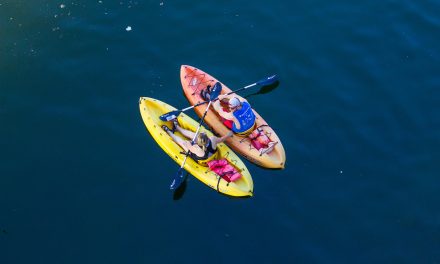Kayaking with your children is an excellent way to combine adventure, exercise, and quality family time. Whether you’re navigating calm rivers or exploring serene lakes, this outdoor activity offers numerous benefits for both parents and kids. From fostering a love for nature to building physical skills, kayaking creates unforgettable memories and valuable life lessons. However, ensuring a fun and safe experience requires careful planning, the right equipment, and a solid understanding of safety measures. This guide will walk you through everything you need to know to enjoy kayaking with your children.
Benefits of Kayaking with Children
Kayaking is more than just an outdoor adventure—it’s an opportunity to create lasting memories while promoting your children’s physical and emotional well-being. This family-friendly activity offers a wide range of benefits:
- Physical Fitness: Kayaking strengthens muscles, improves coordination, and enhances cardiovascular health, making it a fantastic way for children to stay active.
- Nature Connection: Time spent on the water fosters an appreciation for nature, teaching kids to respect and cherish the environment.
- Family Bonding: Sharing a kayak or paddling side by side encourages teamwork, communication, and a sense of togetherness.
- Building Confidence: As children learn new skills like paddling, steering, and balancing, they gain a sense of accomplishment and self-confidence.
By introducing your kids to kayaking, you lay the foundation for a lifelong love of outdoor adventures.
Why Kayaking is Perfect for Family Bonding
Kayaking offers unique opportunities for families to connect and strengthen their relationships. Here’s why:
- Shared Experiences: Experiencing the sights, sounds, and challenges of the water together brings families closer, creating memories to cherish for years to come.
- Problem-Solving: Working as a team to paddle, steer, or navigate obstacles teaches collaboration and patience.
- Unplugged Time: Away from screens and daily distractions, families can focus on genuine, uninterrupted interactions.
- Learning Together: Parents and children often pick up new kayaking skills side by side, encouraging mutual support and motivation.
These shared moments on the water make kayaking one of the best activities for strengthening family connections.
Preparing for a Kayaking Adventure
A successful kayaking trip with your children begins with proper preparation. Taking the time to plan ahead ensures a smooth and enjoyable experience for the entire family. Key steps include:
- Researching Locations: Choose a safe, calm waterway suitable for beginners. Lakes, slow-moving rivers, and sheltered bays are ideal options.
- Assessing Skill Levels: Consider your child’s age, swimming ability, and comfort level in the water. Tailor the trip to match their capabilities.
- Packing Essentials: Bring plenty of water, snacks, sunscreen, and extra clothing. Dry bags are also essential for keeping items protected from water.
- Timing the Trip: Aim for shorter trips to accommodate younger children. Early mornings or late afternoons are perfect for avoiding crowds and harsh sunlight.
By addressing these factors, families can set the stage for a fun and memorable adventure on the water.
Choosing the Right Kayak for Your Family
Selecting the right kayak is a crucial part of preparation. Consider these options to find the best fit for your family:
- Tandem Kayaks: Perfect for younger children who may not paddle independently. These kayaks allow parents to control the majority of the paddling while kids enjoy the ride.
- Sit-on-Top Kayaks: These are stable, easy to climb back onto if someone falls in, and are great for family outings.
- Youth Kayaks: Designed specifically for children, these lightweight kayaks offer better control and help kids feel more independent.
- Inflatable Kayaks: Ideal for families who need portability and storage convenience.
When choosing a kayak, prioritize stability, safety features, and ease of use to ensure everyone has a positive experience on the water.
Safety Tips for Kayaking with Kids
Safety should always be the top priority when kayaking with children. Being well-prepared and aware of potential risks ensures a fun and worry-free adventure. Key safety tips include:
- Life Jackets Are Non-Negotiable: Ensure every family member wears a properly fitted, Coast Guard-approved life jacket at all times.
- Check Weather Conditions: Always check the forecast before heading out. Avoid kayaking in strong winds, heavy rain, or extreme temperatures.
- Start Small: Begin with short outings on calm, flat water to help children build confidence and familiarity with the kayak.
- Practice Water Safety: Teach children basic water safety rules, such as staying close to the kayak and avoiding sudden movements.
- Supervision is Key: Always keep younger children within arm’s reach and older kids within sight.
By adhering to these safety guidelines, parents can create a secure and enjoyable environment for their children on the water.
Essential Gear for Child Safety on the Water
Equipping your family with the right safety gear is critical for a kayaking trip. Here’s a list of must-have items:
- Life Jackets: Choose life jackets designed specifically for children, ensuring a snug yet comfortable fit.
- Whistles: Attach a whistle to each life jacket to help children signal for help if needed.
- Sun Protection: Bring hats, sunglasses with straps, and waterproof sunscreen to protect kids from sunburn.
- Dry Bags: Store extra clothing, snacks, and electronics in waterproof bags to keep them safe from water damage.
- First Aid Kit: Pack a small, waterproof first aid kit with essentials like bandages, antiseptic wipes, and insect repellent.
Investing in quality safety gear ensures that families are prepared for unexpected situations and can focus on enjoying their time on the water.
Teaching Your Children to Paddle
Introducing your children to paddling can be an enjoyable and educational experience. Teaching them proper techniques helps build their skills and confidence on the water. Follow these steps to ensure a smooth learning process:
- Start on Land: Begin by showing them how to hold the paddle and make basic strokes, such as forward and backward paddling, while on dry land.
- Demonstrate First: Once on the water, demonstrate each stroke and explain its purpose. Kids often learn better by watching and copying your movements.
- Encourage Practice: Allow children to experiment with paddling in a safe and calm area. Offer guidance and corrections as needed.
- Focus on Fun: Avoid overwhelming them with technical details. Instead, keep the lesson playful and lighthearted to maintain their enthusiasm.
With patience and positive reinforcement, children can quickly pick up paddling skills and enjoy the independence it brings.
Making Kayaking Fun and Educational
To keep children engaged and entertained during the trip, turn kayaking into an adventure filled with fun and learning opportunities:
- Spot Wildlife: Encourage kids to look for birds, fish, or turtles and learn about their habitats.
- Play Games: Create simple games like “paddle tag” or “who can spot the most interesting thing?”
- Learn Navigation: Teach basic navigation skills by showing them how to use landmarks to find their way back.
- Storytelling: Share stories about the local area or create imaginative tales about the water and surroundings.
- Let Them Lead: Give children a chance to lead the paddling route for a sense of adventure and responsibility.
Combining learning and play keeps the experience memorable while fostering curiosity and confidence.
Top Destinations for Family Kayaking
Choosing the right destination can make your family kayaking trip even more special. Some waterways are perfect for beginners and families, offering calm waters, beautiful scenery, and safe environments. Here are some tips to select ideal destinations:
- Calm and Sheltered Waters: Look for locations like lakes, lagoons, or slow-moving rivers, which are easier for children to navigate.
- Local Parks and Reserves: Many state or national parks offer designated kayaking routes that are family-friendly.
- Short Routes: Choose shorter paddling routes to keep kids engaged without overwhelming them.
- Accessible Launch Points: Ensure the destination has easy access for launching kayaks and plenty of facilities like parking, restrooms, and picnic areas.
Researching destinations beforehand helps families find the perfect spot for a safe and enjoyable adventure.
Exploring Kid-Friendly Waterways
Some destinations stand out for their family-friendly features and picturesque landscapes. Here are a few highly recommended spots:
- Lake Tahoe, California/Nevada: Known for its calm, crystal-clear waters, this is an excellent place for beginners and kids to explore.
- Everglades National Park, Florida: Offers unique wildlife viewing opportunities and calm paddling routes for families.
- Boundary Waters, Minnesota: A vast network of serene lakes and waterways perfect for paddlers of all ages.
- San Juan Islands, Washington: Ideal for spotting seals, otters, and even whales, with plenty of calm areas for families.
- Local Hidden Gems: Research nearby lakes or rivers that offer safe conditions and are easily accessible for families.
Each of these locations provides memorable experiences for families, combining adventure with natural beauty.
Conclusion: Building Lifelong Memories
Kayaking with your children is more than just an outdoor activity—it’s an opportunity to create meaningful memories and foster a love for adventure. Whether exploring tranquil lakes, paddling along scenic rivers, or spotting wildlife together, each outing strengthens family bonds and builds confidence in your little ones. By preparing well, prioritizing safety, and adding a sense of fun, families can enjoy countless unforgettable moments on the water. Embrace the joys of kayaking as a family and embark on adventures that will leave a lasting impact for years to come.




